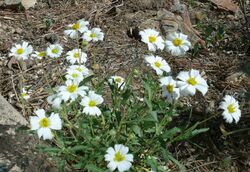Biology:Melampodium leucanthum
| Melampodium leucanthum | |
|---|---|

| |
| Scientific classification | |
| Kingdom: | Plantae |
| Clade: | Tracheophytes |
| Clade: | Angiosperms |
| Clade: | Eudicots |
| Clade: | Asterids |
| Order: | Asterales |
| Family: | Asteraceae |
| Genus: | Melampodium |
| Species: | M. leucanthum
|
| Binomial name | |
| Melampodium leucanthum Torr. & A.Gray
| |
Melampodium leucanthum, the plains blackfoot or blackfoot daisy, is an herbaceous perennial plant in the family Asteraceae found on limestone-containing rocky slopes in the Sonoran Desert.[1]:41 It is an attractive ornamental with showy flowers and long bloom period, from March to November.[1]:41
While it loves limestone-containing rocky slopes, it is also found in the Southwestern region of Kansas and Southeastern region of Colorado; it can be found in Oklahoma too. Blackfoot Daisy is found in high plains as well as mesas and the desert slopes of the Sonoran Desert.[2]
It grows 6" - 12" tall while spreading 12" - 24" wide. Once it found its way into rocky gardens, being cultivated for its drought-tolerant properties, it can be grown up to 4' in height. The leaves are roughly 2" long and are covered in hairs. The center of the flower is a composite flower-head that can have up to 50 individual yellow flowers. There are up to 13 white ray petals that reach from the outside towards the composite head. These white ray petals have a distinctive notch on their outer end.[3]
The plant has a short lifespan and although it dies in the wintertime, its self-seeding process prevents it from dying off completely and gets resurrected from seed.[4]
References
- ↑ 1.0 1.1 Sonoran Desert Wildflowers, Richard Spellenberg, 2nd ed., 2012, ISBN:9780762773688
- ↑ "Plains Blackfoot". https://www.fs.usda.gov/wildflowers/plant-of-the-week/melampodium_leucanthum.shtml.
- ↑ "Melampodium leucanthum (Melampodium) | North Carolina Extension Gardener Plant Toolbox". https://plants.ces.ncsu.edu/plants/melampodium-leucanthum/.
- ↑ "Melampodium leucanthum (Blackfoot Daisy)". 19 September 2023. https://www.gardenia.net/plant/melampodium-leucanthum.
Wikidata ☰ Q3304872 entry
 |

